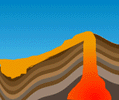

Extrusive igneous rocks result from magma being extruded onto the Earth's surface by volcanic eruptions. These include lava flows and volcanic ash which form from basaltic eruptions or silicic eruptions.
Basaltic eruptions are one of the most common types of volcanic activity on Earth. The lava is generally extruded from fractures or fissures in the earth's surface, where it then flows and spreads out into valleys or depressions in the topography. It occurs along fractures in the oceanic ridge, forming new oceanic crust where the tectonic plates move apart. It also occurs in the volcanic plains and plateaus of the continents.
Two common types of basaltic flows are the 'aa flow' and the 'pahoehoe flow'. The aa flow contains relatively little gas and is a slow moving mass, 3 to 10 metres thick. The surface of the flow cools and forms a crust while the interior remains molten.
The pahoehoe flows are more fluid and not as thick (usually less than 1m thick). They move much faster because of their lower viscosity. The surface of the flow develops a thin, glassy crust, whilst the interior may be massive and nonvesicular. A variety of surfaces develop on basaltic lava flows and reflect the manner of flow, rates of cooling, amounts of dissolved gases, and viscosity. For example, columnar joints, lava tubes, spatter cones, pressure ridges, volcanic bombs, tephra, volcanic ash, cinder cones, shield volcanoes and pillow larva.
Silicic eruptions are when silica rich magmas produce granitic and other associated igneous rocks. Some silicic magmas are so thick and viscous that small volumes will hardly flow at all, but instead form massive plugs or bulbous domes over the volcanic vent. Their high viscosity inhibits the escape of dissolved gas, so tremendous pressure builds up and the eruptions are generally highly explosive and violent.
These eruptions produce large quantities of tephra which produce composite volcanoes (stratovolcano). They can be so explosive that they blow out large volumes of ash and magma which can in turn collapse the summit of the volcanoe. This forms a large basin-shaped depression known as a caldera. Lakes have been known to form in calderas, and if subsequent minor eruptions occur, small volcanic islands are produced in the lake. Ash flow eruptions can also occur but they are rare.

